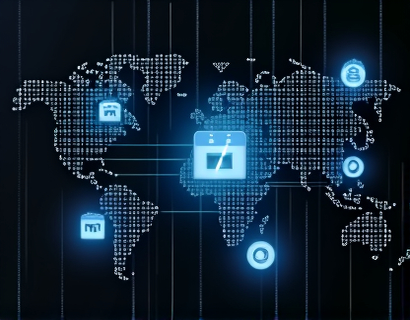Blockchain-Powered Asset Tokenization: Bridging Physical Assets with Digital Liquidity
In the evolving landscape of finance and asset management, the integration of blockchain technology has emerged as a transformative force. One of the most promising applications of blockchain is the tokenization of real-world assets, a process that bridges the gap between physical possessions and digital liquidity. This article delves into the intricacies of blockchain-powered asset tokenization, exploring how it enhances market accessibility and liquidity, and revolutionizes asset management.
Understanding Asset Tokenization
Asset tokenization refers to the process of converting rights to a physical or digital asset into a digital token on a blockchain. These tokens represent fractional ownership or usage rights of the underlying asset, such as real estate, art, machinery, or even intangible assets like patents. The tokenization process leverages blockchain's immutable and transparent ledger to create secure, verifiable, and tradable digital representations of assets.
The primary advantage of tokenization is the democratization of access to traditionally illiquid assets. By breaking down assets into smaller, tradable units, tokenization allows a broader range of investors to participate in the market. This increased participation can lead to more efficient pricing, higher liquidity, and greater market transparency.
Enhancing Market Accessibility
Traditional asset markets are often characterized by high entry barriers, complex regulatory environments, and limited liquidity. Tokenization addresses these challenges by reducing transaction costs, simplifying ownership transfer, and enabling 24/7 trading. For instance, real estate, which has historically been an exclusive market, can now be divided into fractional shares, allowing individuals with smaller capital to invest in high-value properties.
Moreover, tokenization facilitates global access to assets. Investors from around the world can purchase tokens representing assets located in different jurisdictions, thereby expanding their investment horizons without the need for physical presence or extensive local knowledge. This global reach not only increases liquidity but also fosters cross-border collaboration and investment opportunities.
Improving Liquidity
Liquidity is a critical factor in asset markets, as it determines how easily assets can be bought and sold without significantly affecting their price. Tokenized assets benefit from the inherent liquidity of blockchain networks, which support fast and low-cost transactions. The continuous trading of tokens ensures that there is always a market for these assets, reducing the risk of holding illiquid positions.
Additionally, the programmable nature of smart contracts, which govern token transactions, can automate various aspects of asset management. For example, smart contracts can automatically execute dividend payments, maintenance fees, or other obligations associated with asset ownership. This automation streamlines processes, reduces administrative burdens, and enhances the overall efficiency of asset management.
Security and Transparency
One of the most compelling aspects of blockchain technology is its ability to provide a secure and transparent environment for asset transactions. The immutable ledger ensures that all transactions are recorded and cannot be altered, reducing the risk of fraud and disputes. This transparency builds trust among market participants, as they can verify the ownership and history of assets with ease.
Furthermore, blockchain's decentralized nature eliminates the need for intermediaries such as banks or brokers, reducing the potential for errors and delays. This decentralization also enhances security, as there is no single point of failure that can be exploited by malicious actors. The combination of security and transparency makes blockchain-powered asset tokenization an attractive solution for asset managers and investors seeking a more reliable and efficient market.
Challenges and Considerations
Despite its numerous benefits, blockchain-powered asset tokenization is not without challenges. Regulatory uncertainty remains a significant hurdle, as different jurisdictions have varying approaches to digital assets and tokenized securities. Asset managers and investors must navigate a complex regulatory landscape to ensure compliance and avoid legal pitfalls.
Another challenge is the technical complexity involved in tokenizing assets. Creating a robust and secure tokenization system requires expertise in blockchain development, smart contract design, and asset management. This complexity can be a barrier for smaller players in the market, although the growing ecosystem of blockchain service providers is helping to mitigate this issue.
Interoperability between different blockchain platforms is also an area that needs attention. As the market evolves, the ability to seamlessly transfer tokens across various platforms will enhance liquidity and user experience. Standardization efforts and cross-chain solutions are crucial to achieving this goal.
Case Studies and Real-World Applications
Several notable projects have successfully demonstrated the potential of blockchain-powered asset tokenization. One prominent example is RealT, a platform that tokenizes commercial real estate. RealT allows investors to buy, sell, and trade fractional shares of commercial properties, providing access to a previously exclusive market. This innovation has attracted institutional and retail investors alike, showcasing the broad appeal of tokenized real estate.
Another example is the tokenization of art and collectibles. Platforms like SuperRare use blockchain to authenticate and tokenize unique digital art, ensuring provenance and scarcity. This approach not only protects artists and collectors but also opens new avenues for investment in the art market.
In the realm of infrastructure, companies like Ion Exchange have tokenized renewable energy assets, enabling investors to purchase shares of wind and solar power generation. This not only provides a new investment opportunity but also supports the transition to sustainable energy sources.
Future Prospects
The future of blockchain-powered asset tokenization looks promising, with ongoing advancements in technology and increasing regulatory clarity. As more assets are tokenized, the market is expected to become more liquid and accessible. The integration of blockchain with other emerging technologies, such as the Internet of Things (IoT) and artificial intelligence (AI), will further enhance the capabilities of tokenized assets.
For instance, IoT devices can provide real-time data on the condition and usage of physical assets, which can be used to adjust token values dynamically. AI can optimize asset management by predicting market trends and automating investment decisions. These synergies will create a more intelligent and responsive asset market.
Additionally, the rise of decentralized finance (DeFi) platforms is opening new possibilities for tokenized assets. DeFi allows for lending, borrowing, and yield farming of tokens, providing additional liquidity and investment opportunities. As the DeFi ecosystem matures, tokenized assets are likely to play a central role in this innovative financial landscape.
Conclusion
Blockchain-powered asset tokenization represents a paradigm shift in how we think about and manage assets. By leveraging the unique features of blockchain technology, this approach enhances market accessibility, liquidity, and security, while reducing costs and complexities. As the technology continues to evolve and gain regulatory acceptance, the potential applications of asset tokenization will expand, transforming various sectors and creating new opportunities for investors and asset managers.
Embracing blockchain-driven tokenization is not just a trend but a strategic move towards a more inclusive, efficient, and transparent financial future. For those looking to stay ahead in the asset management industry, understanding and adopting tokenization technologies will be crucial.










































